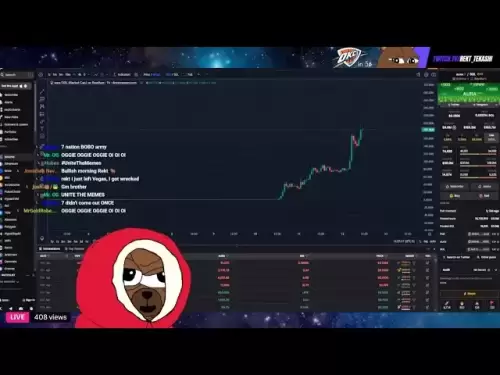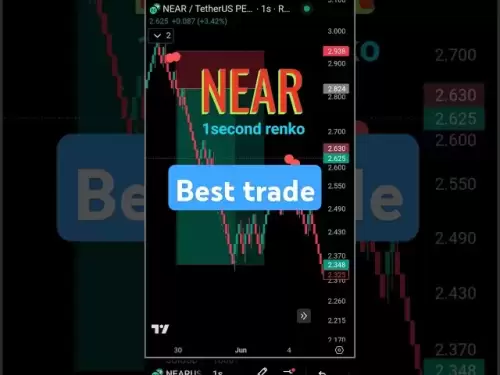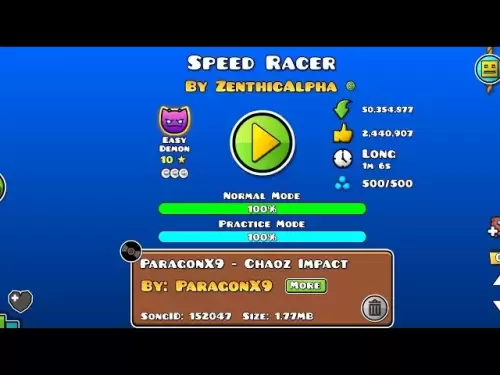-
 Bitcoin
Bitcoin $105,288.6945
-2.61% -
 Ethereum
Ethereum $2,546.9059
-7.84% -
 Tether USDt
Tether USDt $1.0004
0.05% -
 XRP
XRP $2.1438
-4.68% -
 BNB
BNB $653.2251
-1.80% -
 Solana
Solana $146.3449
-8.07% -
 USDC
USDC $0.9997
0.01% -
 Dogecoin
Dogecoin $0.1778
-5.94% -
 TRON
TRON $0.2688
-2.27% -
 Cardano
Cardano $0.6373
-7.04% -
 Hyperliquid
Hyperliquid $41.2776
-4.37% -
 Sui
Sui $3.0223
-9.71% -
 Chainlink
Chainlink $13.3280
-7.77% -
 Bitcoin Cash
Bitcoin Cash $430.6921
-2.12% -
 UNUS SED LEO
UNUS SED LEO $9.0426
1.98% -
 Avalanche
Avalanche $19.2275
-8.92% -
 Stellar
Stellar $0.2600
-5.55% -
 Toncoin
Toncoin $2.9984
-6.13% -
 Shiba Inu
Shiba Inu $0.0...01195
-5.71% -
 Hedera
Hedera $0.1566
-7.37% -
 Litecoin
Litecoin $84.6896
-5.28% -
 Polkadot
Polkadot $3.8188
-6.28% -
 Ethena USDe
Ethena USDe $1.0004
0.00% -
 Monero
Monero $311.9801
-3.66% -
 Dai
Dai $0.9998
0.00% -
 Bitget Token
Bitget Token $4.5149
-4.09% -
 Uniswap
Uniswap $7.4602
-6.13% -
 Pepe
Pepe $0.0...01088
-11.16% -
 Aave
Aave $280.9076
-8.02% -
 Pi
Pi $0.5699
-8.88%
Is the gap necessarily filled? There are exceptions in three cases
In crypto trading, gaps occur when an asset's price opens significantly higher or lower than its previous close, often due to volatility from news or market shifts.
Jun 12, 2025 at 07:07 am

Understanding the Concept of Gaps in Cryptocurrency Trading
In the context of cryptocurrency trading, a gap refers to a situation where the price of a digital asset opens significantly higher or lower than its previous closing price, with no trading activity occurring between these two points. This phenomenon is commonly observed during periods of high volatility, especially when markets react strongly to news events, regulatory changes, or macroeconomic factors.
Gaps are particularly relevant in crypto due to the 24/7 nature of the market. Unlike traditional stock exchanges that close overnight, crypto markets never stop, but significant price movements can still occur between major trading sessions or after sudden announcements. Traders often wonder whether these gaps will eventually be filled — meaning the price will return to the level before the gap occurred.
Key Insight: The idea that every gap must be filled is a common misconception in both traditional and crypto trading.
Why Some Believe Every Gap Must Be Filled
Many traders operate under the assumption that gaps tend to get filled because prices naturally revisit areas of imbalance. In technical analysis, this belief stems from the notion that untested price levels create uncertainty and attract retracements. For example, if Bitcoin (BTC) closes at $30,000 and opens the next day at $31,000 without any trades happening in between, some analysts believe the price will eventually return to $30,000 to fill the gap.
This logic applies more consistently in traditional markets, where gaps are limited to specific timeframes like overnight or weekends. However, in the continuous environment of cryptocurrency, the dynamics change. Price action is non-stop, and gaps may not always behave as expected.
Important Note: In crypto, gaps can appear and disappear quickly due to rapid price fluctuations and varying exchange data feeds.
Three Exceptions Where Gaps Do Not Get Filled
While many gaps do get filled over time, there are notable exceptions. These scenarios typically involve strong momentum, fundamental shifts, or extreme market sentiment that prevents a retrace to the original gap area.
- Strong Trend Continuation: When a powerful trend is underway, the market may not look back. For instance, if Ethereum (ETH) surges due to a major network upgrade, the upward momentum could carry the price far beyond the gap zone without revisiting it.
- Fundamental Shifts: Events such as regulatory approvals, institutional adoption, or project upgrades can cause permanent shifts in value. If Solana (SOL) gets listed on a major global exchange, the resulting demand surge might push the price into a new range without filling prior gaps.
- Extreme Market Conditions: During black swan events or panic selling, gaps can form and remain unfilled indefinitely. The 2020 "Bitcoin crash" saw massive gaps form that were never fully closed, especially during the initial drop phase.
Crucial Detail: Each exception reflects a shift in market psychology and structure that overrides the typical behavior of price retracing gaps.
Analyzing Gaps Using Technical Tools in Crypto
To assess whether a gap might be filled, traders use various technical indicators and charting tools. Candlestick patterns, volume profiles, and moving averages help identify potential support and resistance zones around the gap area.
Here’s how you can analyze a gap effectively:
- Check Volume at the Gap Zone: Low volume during the formation of the gap suggests weak interest and a higher likelihood of the gap being filled.
- Use Fibonacci Retracements: Overlay Fibonacci levels to see if the gap lies within a key retracement zone. If so, the probability of a return increases.
- Monitor Moving Averages: If the gap occurs above or below a major moving average (e.g., 50-day or 200-day), it may indicate a stronger trend that avoids retracement.
Pro Tip: Combine multiple tools for better accuracy rather than relying solely on one indicator.
Practical Steps for Trading Around Gaps
If you’re considering trading based on gap behavior, follow these steps to improve your strategy:
- Identify the Gap Type: Determine whether it’s a breakaway gap, runaway gap, or exhaustion gap. Each has different implications for future price movement.
- Set Entry Points Carefully: If you expect a gap to be filled, wait for confirmation via candlestick reversal patterns or volume spikes before entering a trade.
- Place Stop-Loss Orders Strategically: Set stops just beyond the gap area to avoid getting stopped out by false breakouts or short-term volatility.
- Use Time-Based Filters: Some traders set time limits (e.g., 5–10 candles) for a gap to be filled. If it doesn’t happen within that window, they abandon the trade idea.
Critical Reminder: Always manage risk carefully, as gaps can behave unpredictably in fast-moving crypto markets.
FAQ: Frequently Asked Questions About Gaps in Crypto
Q: Are all gaps visible across all exchanges?
A: No. Due to differences in liquidity and exchange-specific price feeds, gaps may appear on one platform but not another. It's important to verify using reliable charting platforms like TradingView or CoinMarketCap.
Q: Can gaps be used as standalone signals for trading?
A: While gaps can offer useful insights, they should not be used alone. Combining them with other indicators like RSI, MACD, or volume helps filter false signals and increase accuracy.
Q: How long does it usually take for a gap to be filled?
A: There’s no fixed timeline. Some gaps get filled within minutes, while others remain open for weeks or even months. Timeframe analysis and market context play crucial roles in predicting outcomes.
Q: Is it possible to automate gap-based trading strategies?
A: Yes. Many algorithmic traders use bots to detect and execute trades based on gap conditions. However, constant monitoring and adjustments are necessary due to the volatile nature of crypto assets.
Disclaimer:info@kdj.com
The information provided is not trading advice. kdj.com does not assume any responsibility for any investments made based on the information provided in this article. Cryptocurrencies are highly volatile and it is highly recommended that you invest with caution after thorough research!
If you believe that the content used on this website infringes your copyright, please contact us immediately (info@kdj.com) and we will delete it promptly.
- Bitwise CEO Predicts Bitcoin Holders Will Stop Selling Once Price Surpasses $130,000
- 2025-06-14 01:30:12
- Neo Pepe’s Revolution Begins
- 2025-06-14 01:30:12
- Aptos (APT) Token Unlock – June 12, 2025
- 2025-06-14 01:25:12
- Aptos (APT) Token Unlock – June 12, 2025
- 2025-06-14 01:25:12
- Ruvi AI Emerges as a Potential Rival to Cardano (ADA)
- 2025-06-14 01:20:12
- Market Capitalization Often Confuses Casual Investors, and Detractors Have Weaponized It Against Bullish XRP Price Predictions
- 2025-06-14 01:20:12
Related knowledge
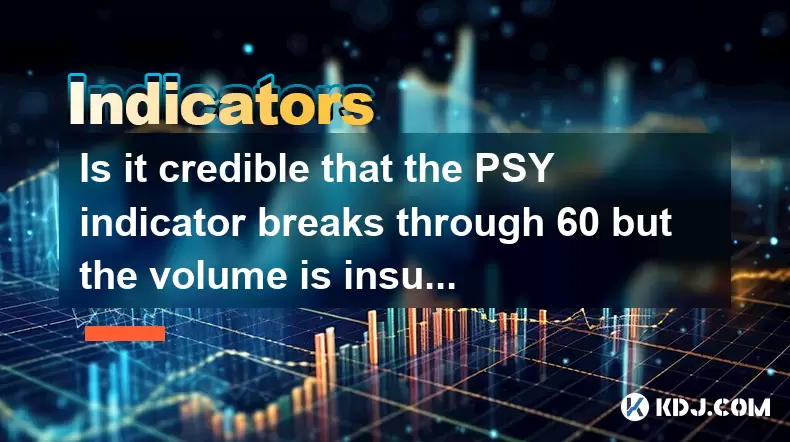
Is it credible that the PSY indicator breaks through 60 but the volume is insufficient?
Jun 14,2025 at 12:14am
Understanding the PSY Indicator in Cryptocurrency TradingThe Psychological Line (PSY) indicator is a momentum oscillator used primarily to measure the sentiment of traders and investors in financial markets, including the cryptocurrency space. It calculates the ratio of days where prices closed higher versus lower over a specified period, typically 12 o...
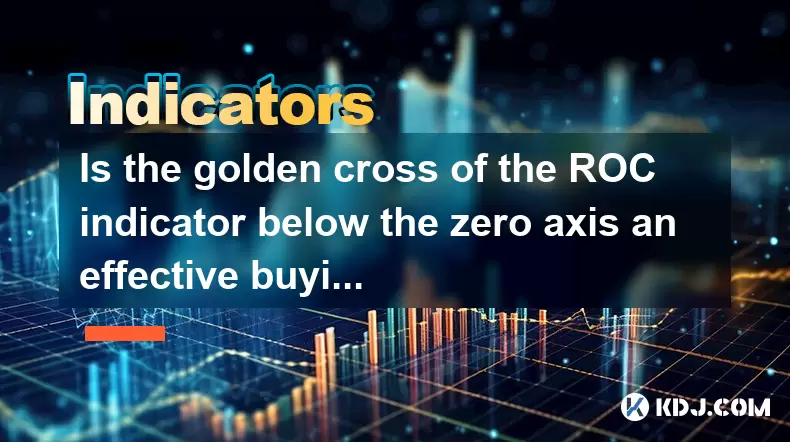
Is the golden cross of the ROC indicator below the zero axis an effective buying point?
Jun 14,2025 at 01:29am
Understanding the ROC Indicator and Its SignificanceThe Rate of Change (ROC) indicator is a momentum oscillator used in technical analysis to measure the percentage change in price between the current closing price and the closing price from a set number of periods ago. This tool helps traders assess the speed at which prices are changing, offering insi...

Will the RSI fall after the top divergence? How to improve the judgment accuracy?
Jun 13,2025 at 11:21pm
Understanding RSI and Top Divergence in Cryptocurrency TradingThe Relative Strength Index (RSI) is a momentum oscillator widely used in cryptocurrency trading to measure the speed and change of price movements. It typically ranges from 0 to 100, with levels above 70 considered overbought and below 30 considered oversold. In crypto markets, where volatil...
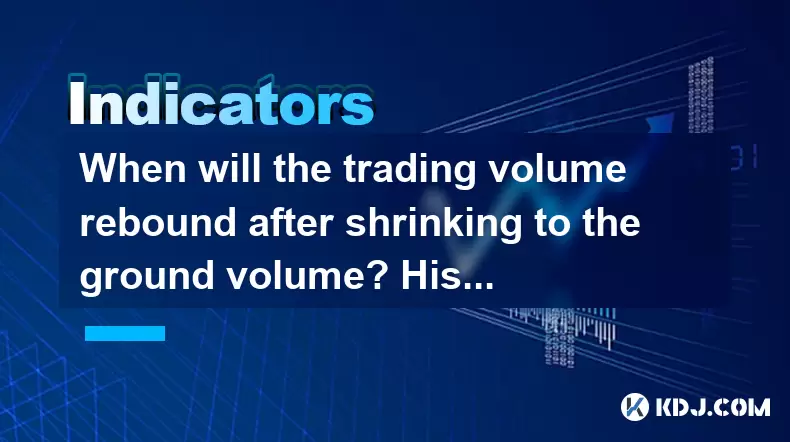
When will the trading volume rebound after shrinking to the ground volume? Historical percentile comparison method
Jun 13,2025 at 03:36pm
Understanding the Ground Volume Concept in Cryptocurrency MarketsIn cryptocurrency trading, 'ground volume' refers to a period when the trading volume of a particular asset or market drops significantly, often reaching multi-month or even multi-year lows. This phenomenon typically signals a lack of interest from traders and investors, suggesting that th...
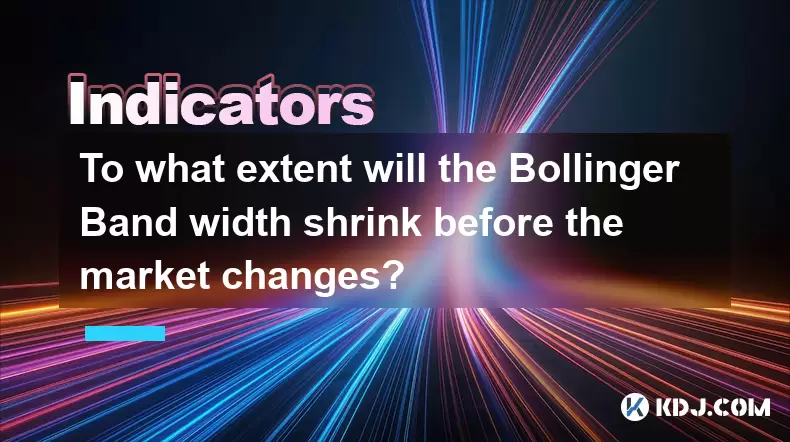
To what extent will the Bollinger Band width shrink before the market changes?
Jun 13,2025 at 06:35pm
Understanding the Bollinger Band Width and Its SignificanceThe Bollinger Band width is a critical technical analysis tool used in cryptocurrency trading to measure market volatility. It consists of three lines: a simple moving average (SMA), an upper band, and a lower band. The distance between the upper and lower bands reflects the level of volatility ...
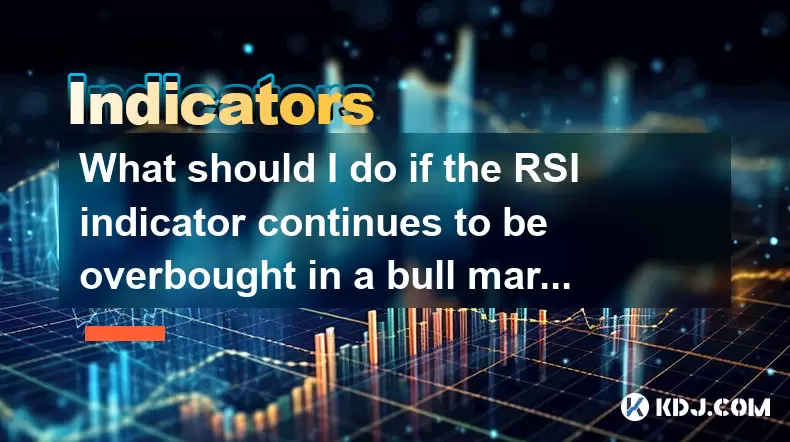
What should I do if the RSI indicator continues to be overbought in a bull market? How to adjust the overbought zone threshold?
Jun 13,2025 at 05:57pm
Understanding the RSI Indicator in a Bull MarketThe Relative Strength Index (RSI) is a momentum oscillator commonly used by traders to assess overbought or oversold conditions of an asset. In a bull market, especially within the cryptocurrency space, prices can remain elevated for extended periods. This often leads to the RSI indicator staying in the ov...

Is it credible that the PSY indicator breaks through 60 but the volume is insufficient?
Jun 14,2025 at 12:14am
Understanding the PSY Indicator in Cryptocurrency TradingThe Psychological Line (PSY) indicator is a momentum oscillator used primarily to measure the sentiment of traders and investors in financial markets, including the cryptocurrency space. It calculates the ratio of days where prices closed higher versus lower over a specified period, typically 12 o...

Is the golden cross of the ROC indicator below the zero axis an effective buying point?
Jun 14,2025 at 01:29am
Understanding the ROC Indicator and Its SignificanceThe Rate of Change (ROC) indicator is a momentum oscillator used in technical analysis to measure the percentage change in price between the current closing price and the closing price from a set number of periods ago. This tool helps traders assess the speed at which prices are changing, offering insi...

Will the RSI fall after the top divergence? How to improve the judgment accuracy?
Jun 13,2025 at 11:21pm
Understanding RSI and Top Divergence in Cryptocurrency TradingThe Relative Strength Index (RSI) is a momentum oscillator widely used in cryptocurrency trading to measure the speed and change of price movements. It typically ranges from 0 to 100, with levels above 70 considered overbought and below 30 considered oversold. In crypto markets, where volatil...

When will the trading volume rebound after shrinking to the ground volume? Historical percentile comparison method
Jun 13,2025 at 03:36pm
Understanding the Ground Volume Concept in Cryptocurrency MarketsIn cryptocurrency trading, 'ground volume' refers to a period when the trading volume of a particular asset or market drops significantly, often reaching multi-month or even multi-year lows. This phenomenon typically signals a lack of interest from traders and investors, suggesting that th...

To what extent will the Bollinger Band width shrink before the market changes?
Jun 13,2025 at 06:35pm
Understanding the Bollinger Band Width and Its SignificanceThe Bollinger Band width is a critical technical analysis tool used in cryptocurrency trading to measure market volatility. It consists of three lines: a simple moving average (SMA), an upper band, and a lower band. The distance between the upper and lower bands reflects the level of volatility ...

What should I do if the RSI indicator continues to be overbought in a bull market? How to adjust the overbought zone threshold?
Jun 13,2025 at 05:57pm
Understanding the RSI Indicator in a Bull MarketThe Relative Strength Index (RSI) is a momentum oscillator commonly used by traders to assess overbought or oversold conditions of an asset. In a bull market, especially within the cryptocurrency space, prices can remain elevated for extended periods. This often leads to the RSI indicator staying in the ov...
See all articles





















